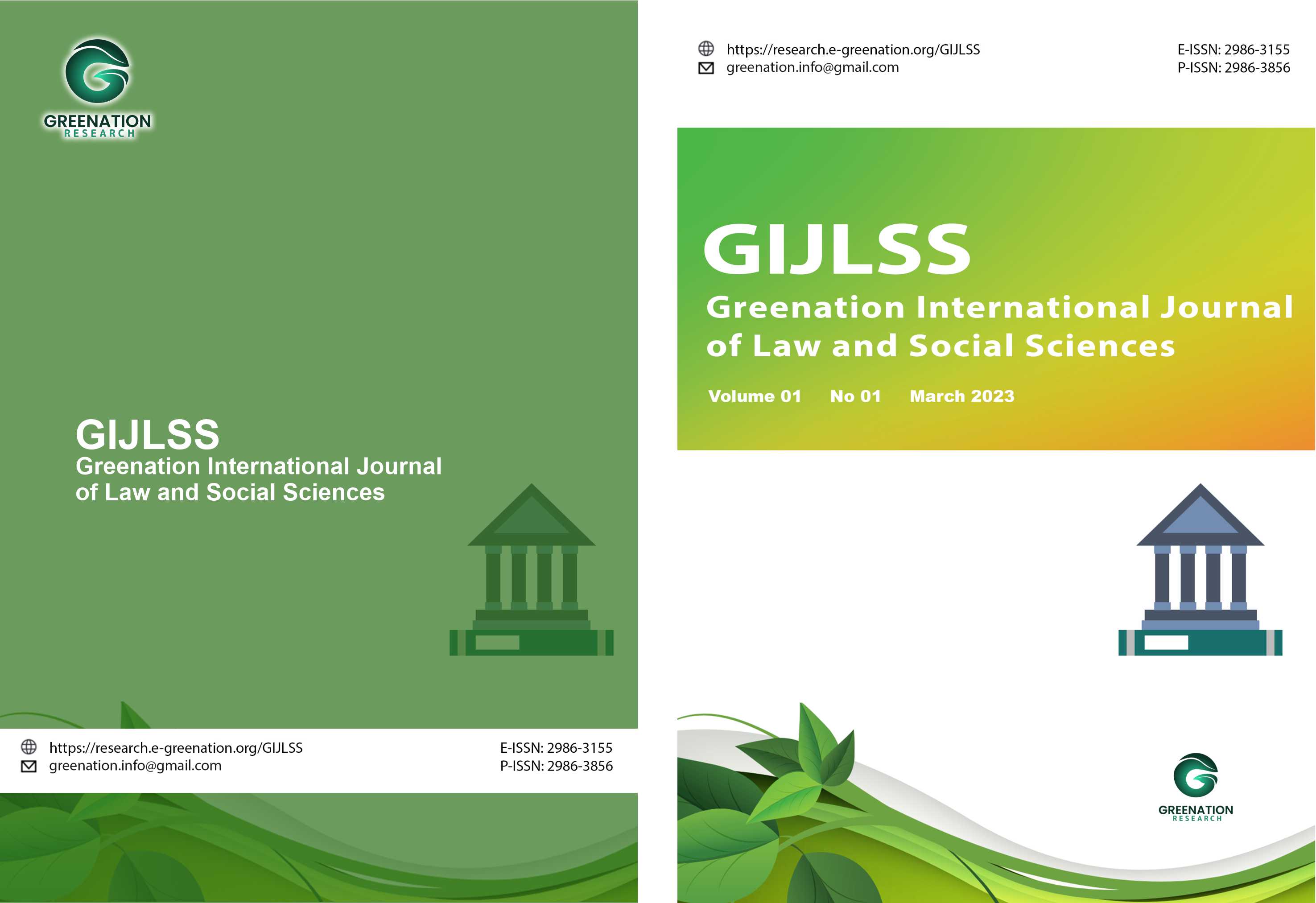Utilization of Artificial Intelligence (AI) in Mobile Applications to Ensure the Personal and Legal Safety, Security, and Welfare of Informal Migrant Workers Based on Real Just-in-Time (RJIT) Conditions Abroad
DOI:
https://doi.org/10.38035/gijlss.v3i2.423Keywords:
Informal Migrant Workers, AI Artificial Intelligence, Real-Just-In-Time (RJIT) Information, Emergency Response, Mobile Application, Personal Safety and Welfare, Legal Standing/Safety/SecurityAbstract
Indonesian informal migrant workers’ long history of violence and other victimized experiences, crucial to be solved by the Indonesian government (and representatives of various countries) by getting real just-in-time (RJIT) updates about the migrant workers' situations. These updates play their role in the database information system and RJIT monitoring of informal migrant workers through situations, and conditions, including their legal standing. Advanced AI utilization might even save migrant workers' lives and/or health as it might be set as an emergency button that connects informal migrant workers to local emergency services (fast response), on-site Indonesian government representatives, and other necessary entities. It might also become the first pace of legal monitoring and protection for migrant workers. Using the empiric juridic methodology, this paper analyzed various regulations related to migrant workers, rules, and laws interaction, and examined the implementation of (AI-based) applications on migrant workers in multiple countries. AI's key focus role lies on features effectivity (location tracking, physical identification, emergency notification, risk assessment notification based on RJIT information), legal-info-chatbot (LIC), and legal counsel assistance (LCA). The research showed that integrated advanced and comprehensive RJIT-AI features in migrant workers’ mobile applications positively contributed to improved access to justice, emergency case response, and handling, benefits for the safety and welfare of migrant workers, and function for any related parties. This research recommended regulations strengthening and cross-country synergies in supporting AI technology utilization on informal migrant workers through a protection system.
References
Adriyan, R. A. (2024). HUKUM MODERN. Didaktik: Jurnal Ilmiah PGSD STKIP Subang, 10(04), 445-457.
Auliaillah, D. &. (2024). Perlindungan Tenaga Kerja Migran Dari Kejahatan Lintas Negara Dalam Upaya Penegakan Hak Asasi Manusia. Media Hukum Indonesia (MHI), 2(3).
Fikri, S. (2022). Perlindungan Dan Pemenuhan Hak Asasi Manusia Bagi Pekerja Migran Indonesia Di Luar Negeri. Morality: Jurnal Ilmu Hukum, 8(2), 108-126.
Hasan, M. K. (2024). Penerapan Sistem Informasi Berbasis AI untuk Analisis Data Real-time. Padang: Takaza Innovatix Labs.
Jatmiko, L. J. (2025). Perjanjian Kerja Sebagai Upaya P Perjanjian Kerja Sebagai Upaya Perlindungan serta Pemenuhan Hak-Hak Asasi Manusia untuk Pekerja Migran Indonesia: Perjanjian Kerja Sebagai Upaya Perlindungan serta Pemenuhan Hak-Hak Asasi Manusia untuk Pekerja Migran Indon. The Prosecutor Law Review, 3(1).
Kristiadi, E. Y. (2022). Perlindungan Hukum Terhadap Pekerja Migran Indonesia. Jurnal Pendidikan Kewarganegaraan Undiksha, 10(1), 312-317.
Masrichah, S. (2023). Ancaman dan peluang artificial intelligence (AI). Khatulistiwa: Jurnal Pendidikan dan Sosial Humaniora, 3(3), 83-101.
Mawikere, A. G. (2024). Perlindungan Hukum Terhadap Pekerja Migran Indonesia Berdasarkan Undang-Undang Nomor 18 Tahun 2017. Lex Privatum, 14(1).
Mita Noveria, D. K. (2021). Perlindungan Pekerja Migran Indonesia. Jakarta: Yayasan Pustaka Obor Indonesia.
Permana, Y. P. (2025). Kecerdasan Buatan: Mengubah Dunia dengan Teknologi. Sumedang: MEGA PRESS NUSANTARA.
Purnawati, N. W. (2024). Sistem Informasi: Teori dan Implementasi Sistem Informasi di berbagai Bidang. Jambi: PT. Sonpedia Publishing Indonesia.
Putra, G. A. (2023). Tantangan Hukum: Keakuratan Informasi Layanan AI Chatbot Dan Pelindungan Hukum Terhadap Penggunanya. Jurnal Rechts Vinding: Media Pembinaan Hukum Nasional, 12(2).
Rosalina, H. N. (2020). Perlindungan Hukum Terhadap Pekerja Migran Sektor Informal dalam Perspektif Teori Bekerjanya Hukum di Masyarakat. Jurnal Pembangunan Hukum Indonesia, 2(2), 174-187.
Safitri, D. &. (2023). Keamanan Manusia Pekerja Migran Indonesia: Ketidakamanan dan Perlindungannya. Intermestic: Journal of International Studies, 7(2), 741-769.
Sakti, L. S. (2024). PEMENUHAN HAK KONSTITUSIONAL PEKERJA MIGRAN INDONESIA ILEGAL DI LUAR NEGERI. Jurnal Hukum Agama Hindu Widya Kerta, 7(2), 90-104.
Shaliha, R. &. (2023). Tinjauan yuridis perlindungan hukum jaminan sosial bagi pekerja migran berdasarkan undang–undang nomor 18 tahun 2017 tentang perlindungan pekerja migran indonesia. Indonesia Berdaya, 4(1), 389-396.
Sinaga, B. B. (2024). Peran Teknologi Blockchain Sebagai Instrumen Pembangunan Penegakan Hukum Berbasis Digital & Mewujudkan Masyarakat Berkeadilan di Era Society 5.0. Padjadjaran Law Review, 12(1), 71-82.
Situmorang, B. A. (2021). Perlindungan Hukum Terhadap Pekerja Migran Indonesia Informal Menurut Undang Undang Nomor 18 Tahun 2017 Tentang Perlindungan Pekerja Migran. Jurnal Ilmiah Metadata, 3(2), 669-693.
Wibowo, A. W. (2023). Pemolisian digital dengan artificial intelligence. Depok: PT. RajaGrafindo Persada-Rajawali Pers.
Yuliastuti, B. C. (2024). Penerapan Peraturan Menteri Ketenagakerjaan Nomor 4 Tahun 2023 Terhadap Perlindungan Jaminan Sosial Pekerja Migran Indonesia. UNES Law Review, 6(4), 11167-11183.
Downloads
Published
How to Cite
Issue
Section
License
Copyright (c) 2025 Dwi Arie Isdiyanto, Azis Budianto

This work is licensed under a Creative Commons Attribution 4.0 International License.
Copyright :
Authors who publish their manuscripts in this journal agree to the following conditions:
- Copyright in each article belongs to the author.
- The author acknowledges that the Greenation International Journal of Law and Social Sciences (GIJLSS) has the right to be the first to publish under a Creative Commons Attribution 4.0 International license (Attribution 4.0 International CC BY 4.0).
- Authors can submit articles separately, arrange the non-exclusive distribution of manuscripts that have been published in this journal to other versions (for example, sent to the author's institutional repository, publication in a book, etc.), by acknowledging that the manuscript has been published for the first time at GIJLSS.
























